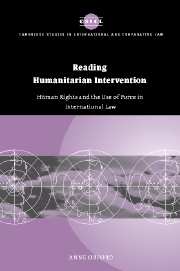Book contents
- Frontmatter
- Contents
- Preface
- 1 Watching East Timor
- 2 Misreading the texts of international law
- 3 Localizing the other: the imaginative geography of humanitarian intervention
- 4 Self-determination after intervention: the international community and post-conflict reconstruction
- 5 The constitution of the international community: colonial stereotypes and humanitarian narratives
- 6 Dreams of human rights
- Bibliography
- Index
- CAMBRIDGE STUDIES IN INTERNATIONAL AND COMPARATIVE LAW
3 - Localizing the other: the imaginative geography of humanitarian intervention
Published online by Cambridge University Press: 05 July 2009
- Frontmatter
- Contents
- Preface
- 1 Watching East Timor
- 2 Misreading the texts of international law
- 3 Localizing the other: the imaginative geography of humanitarian intervention
- 4 Self-determination after intervention: the international community and post-conflict reconstruction
- 5 The constitution of the international community: colonial stereotypes and humanitarian narratives
- 6 Dreams of human rights
- Bibliography
- Index
- CAMBRIDGE STUDIES IN INTERNATIONAL AND COMPARATIVE LAW
Summary
This chapter explores one of the ways in which international legal texts shape the meanings that are made of humanitarian intervention. My focus is on the ways in which such texts understand the causes of security and humanitarian crises in the post-Cold War period. In particular, I am interested in two key assumptions that underpin the arguments in favour of humanitarian intervention. First, state or local leaders or governments are presented as posing the major challenges to human rights and democracy, and humanitarian crises are seen as largely caused by actions and developments initiated and carried out by local or governmental actors or institutions. These actors are usually represented as being driven by forms of premodern tribalism, ethnic tensions and religious factionalism, which are channeled by ruthless political elites into genocidal violence. This provides a motivating factor for intervention – in order to restore order or to guarantee human rights and democracy, military intervention is necessary. International law and the international community are portrayed as the bearers of peace, democracy and human rights to local communities in need of saving. It is this vision, for instance, which underpins the portrayal of the role of the UN in then Secretary-General Boutros Boutros-Ghali's report, An Agenda for Peace:
In these past few months a conviction has grown, among nations large and small, that an opportunity has been regained to achieve the great objectives of the Charter – a United Nations capable of maintaining international peace and security, of securing justice and human rights and of promoting, in the words of the Charter, ‘social progress and better standards of life in larger freedom’. This opportunity must not be squandered.
- Type
- Chapter
- Information
- Reading Humanitarian InterventionHuman Rights and the Use of Force in International Law, pp. 82 - 125Publisher: Cambridge University PressPrint publication year: 2003



